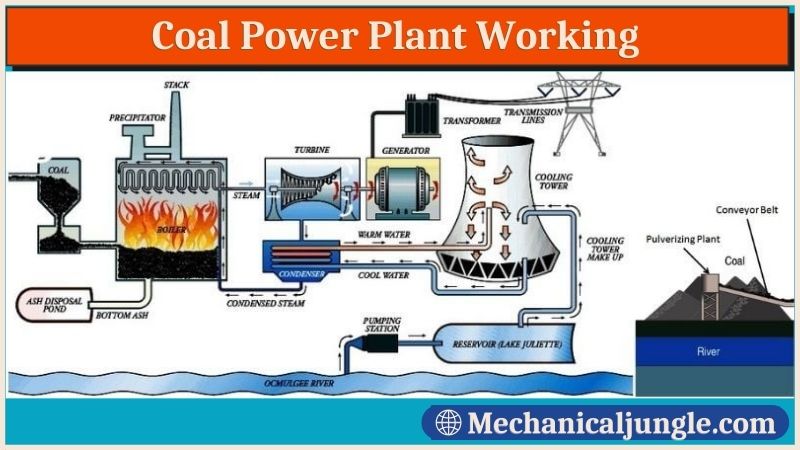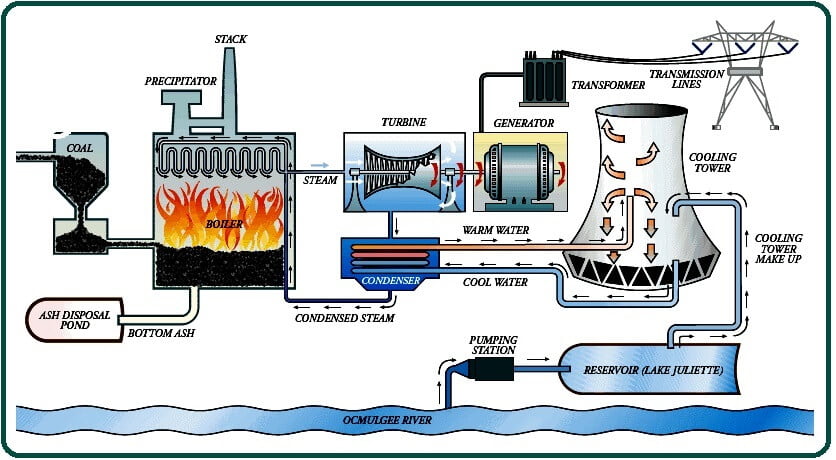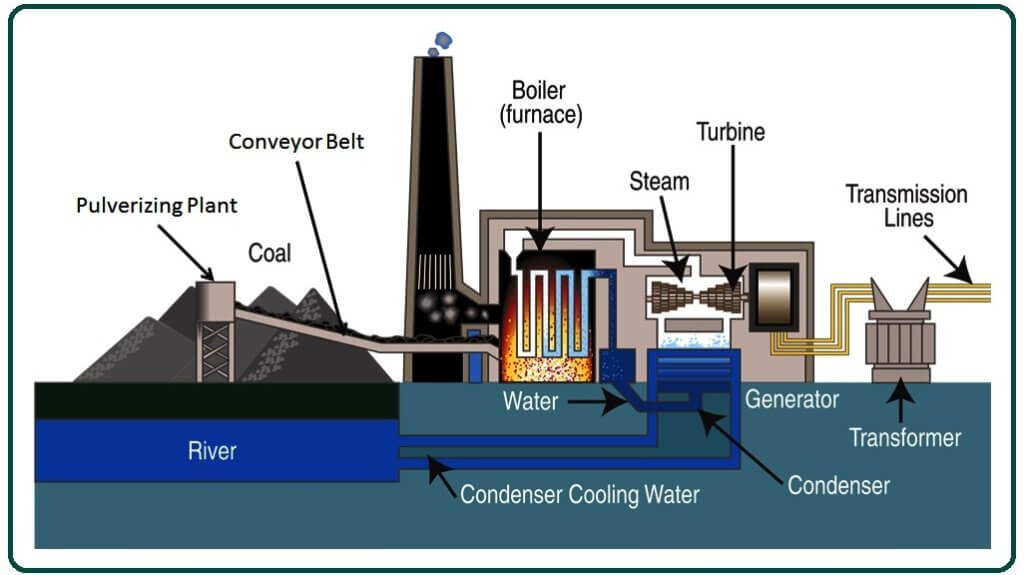
Coal-Fired Power Plant:
Coal-based power plants are a type of power plant that uses coal combustion to generate electricity. Countries like South Africa use coal for 94% of their electricity, and China and India use 70-75% of coal for their electricity needs; however, the amount of coal in China dwarfs that in other countries.
Their use provides about 40% of the world’s electricity, and they are mainly used in developing countries.
The use of coal provides electricity to those who did not have it before, which helps to increase the quality of life & reduce poverty in those areas; however, it produces a large number of various pollutants that are used in the air. Reduces quality and contributes to climate change.
Working of Coal Power Plant:

The work of the coal power plant begins with the arrival of coal from the coal mines via trains. This coal is then transported to the power plant to be converted into a powder form.
The main reason behind converting it into powders is to increase the efficiency of burning by increasing its contact area exposed to fire in the burner as compared to solid coal.
This coal dust is fed through a blower in the boiler; The thermal energy released from this fuel is used to boil water up to 1000 degrees Fahrenheit, thus converting it into high-pressure steam that is transferred to turbines. This energy is used to generate electricity through a generator.
Due to such high RPM, the voltage output of the generator is approximately 24000 volts, which can be transferred to about 40,000 volts via transmission cables. The steam is expanded one by one in 3 consecutive turbines to take full advantage of the pressure energy.
These turbines actually turn at high RPMs, which convert pressure energy into mechanical energy. The temperature of thises water is kept under a safe range so that it does not harm the aquatic lives of the water body.
Furthermore, to extract heat from this steam, the cold water of the reservoir or river is pumped into the condenser, and after heat exchange, it is pumped back into the water body.
Main Components of Coal Power Plant:

#1. Conveyor Belt
Coals from the coal storage area are transported to the plant through a large conveyor belt. The load-carrying capacity of this belt is very high because very large quantities of coal are required every day.
#2. Pulverizing Plant
The coal transported by conveyor cannot be used in the same way as previously converted to powder, also known as inflated coal. It is designed to rotate in a cylindrical tank at high speed with several spherical steel balls and is thus converted into powder.
The pulverizing plant also has un-pulse-enhanced coal storage and can store up to 30 hours of coal reserves.
#3. Boiler
The inflated coal is fed into the boiler through large fans flowing hot air. The boiler consists of several water-filled taps, and these tubes boil water up to 1000 degrees Fahrenheit and the flames in the boiler go up to 50 meters.
#4. Turbine
High-pressure steam at a thousand degrees Fahrenheit from the boiler and 3500 pounds per square inch of pressure is then fed to the steam turbine, which converts its pressurized energy into mechanical energy.
#5. Generator
A generator uses the mechanical energy generated by the turbines to generate electricity at significantly higher voltages.
#6. Condenser
The steam leaving the turbines is condensed into a condenser, which is pumped back into the boiler. Coldwater from a water source (river) or expansion process is used to cool steam into water.
Pollution Control of Coal Power Plant:
The biggest drawback of a coal power plant is its fly ash content and the release of sulfur dioxide during coal burning.
All coal-fired power plants are always under the scrutiny of agencies involved in environmental pollution. Also, there is always pressure on developing countries to keep their pollution levels under control.
Smoke-blowing ash is removed by a mechanical process, while sulfur dioxide is removed by reactions with lime, thus converting it into gypsums, which can be used in agricultural fields & many.
There are other applications. The entire process takes place in a scrubber that is located between the boiler and the chimney.
A mixture of lime and water is sprayed on the smoke emanating from the boiler, reducing the amount of ash blowing in the air by one percent and reducing the amount of sulfur dioxide by 93%.
Preplated fly ash can also be used in making concrete & other anti-skid road materials. In some coal power plants, nitrogen dioxides are also removed from the smoke. It is passed into cars through a catalytic converter to remove nitrogen dioxide.
The catalytic converter consists of layers of ammonia. When nitrogen dioxide is passed through these layers, it reacts with ammonia and is converted to nitrogen and water. Nitrogen is released into the atmosphere because the amount of nitrogen in the air we breathe is 71%, so it is quite safe.
Advantages of Coal Power Plant:
- It is one of the most reliable sources of energy, considering other power plants that depend on weather conditions, such as wind power plants and hydropower plants.
- It is the cheapest source of energy available to produce electricity for the good economic development of the country.
- Its end products, such as gypsum and precipitated ash, can be used in many applications.
- It is available in plenty, so there will be no interruptions in production in the coming years.
- Keeping India in mind, this energy generation tool employs a large part of the population.
Disadvantages of Coal Power Plant:
- It pollutes the environment by releasing harmful gas such as sulfur dioxide and nitrogen dioxide.
- Coal mines leave people with their own homes, as it is not safe to live in an area with mines.
- These gases have a harmful greenhouse effect, which is the most dangerous thing given the current environmental conditions.
- The carbon material released from the chimney in the form of fly ash pollutes the environment in the most adverse way.
Application of Coal Power Plant:
- The coal power plant produces a large amount of electricity for our homes, hospital, industries, schools, etc.
- Coal has been used as a fuel source for locomotives for years.
Frequently asked questions (FAQs) that could be included in your article about coal-fired power plants:
What is a coal-fired power plant?
A coal-fired power plant is a facility that generates electricity by burning coal. It converts the thermal energy released from coal combustion into electrical energy.
How does a coal-fired power plant work?
Coal is pulverized into a fine powder and then burned in a boiler to produce high-pressure steam. This steam drives turbines connected to generators, which produce electricity.
What are the main components of a coal power plant?
The main components include a conveyor belt for coal transport, a pulverizing plant to turn coal into powder, a boiler to generate steam, turbines to convert steam energy into mechanical energy, a generator to produce electricity, and a condenser to recycle steam back into water.
What pollutants do coal power plants emit?
Coal power plants emit pollutants such as sulfur dioxide (SO2), nitrogen dioxide (NO2), and particulate matter (fly ash). These pollutants contribute to air pollution and have environmental and health impacts.
How does a coal power plant control pollution?
Pollution control methods include using scrubbers to remove sulfur dioxide, precipitators to capture fly ash, and technologies to reduce nitrogen oxide emissions. These methods help mitigate the environmental impact of coal combustion.
What are the advantages of coal-fired power plants?
Coal power plants are reliable sources of electricity, provide a stable energy supply unaffected by weather conditions, and are relatively inexpensive compared to other energy sources.
What are the disadvantages of coal-fired power plants?
They contribute significantly to air pollution and greenhouse gas emissions, require extensive mining which can disrupt communities and ecosystems, and pose environmental challenges such as coal ash disposal.
What are the applications of coal-fired power plants?
Coal power plants supply electricity for residential, industrial, and commercial use. Coal is also used in other applications such as in locomotives and as a source of by-products like gypsum for construction materials.
How does coal contribute to global electricity production?
Coal-fired power plants generate approximately 40% of the world’s electricity, with varying reliance among countries depending on their energy infrastructure and resources.
What is the future outlook for coal-fired power plants?
The future of coal-fired power plants is influenced by efforts to reduce emissions, increase efficiency, and diversify energy sources. There is ongoing debate about their role in a sustainable energy transition.

